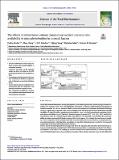Por favor, use este identificador para citar o enlazar a este item:
http://hdl.handle.net/10261/278053COMPARTIR / EXPORTAR:
 SHARE SHARE
 CORE
BASE CORE
BASE
|
|
| Visualizar otros formatos: MARC | Dublin Core | RDF | ORE | MODS | METS | DIDL | DATACITE | |

| Título: | The effects of subterranean estuary dynamics on nutrient resource ratio availability to microphytobenthos in a coastal lagoon |
Autor: | Rocha, Carlos; Jiang, Shan; Ibánhez, J. Severino P. CSIC ORCID; Yang, Quiang; Mazi, Katerina; Koussis, Antonis D. | Palabras clave: | Groundwater recharge dynamics Subterranean estuary Submarine groundwater discharge Semi-arid climate Coastal lagoons Benthic primary production Nutrients |
Fecha de publicación: | 2022 | Editor: | Elsevier | Citación: | Science of the Total Environment 851(1): 157522 (2022) | Resumen: | Causal links between subterranean estuary (STE) dynamics, their climatological drivers, and the ecology of coastal ecosystems have remained elusive. Yet, establishing these connections is essential for fully integrated management of coastal ecosystems. We test, in a semi-arid climate, whether the composition of submarine groundwater discharge (SGD) to a lagoon can be regulated by the annual oscillation of the local STE, itself driven by groundwater recharge variability. We study STE outflow samples gathered monthly for a year in the Ria Formosa lagoon, examining the temporal dynamics of salinity, EH, pH (Total scale), dissolved oxygen and nutrient (PO43−, NO2−, NO3−, NH4+, and Si(OH)4) concentrations under the local hydrological regime. The objectives were threefold: (1) to determine the annual variability of nutrient content and N:P:Si stoichiometry in SGD into the lagoon; (2) to identify the main drivers of variability in SGD composition and stoichiometry and their interactive effects; (3) to discuss links to, and implications for, ecosystem function that could help define expectations of cause-effect relationships and be useful for environmental management of the lagoon and similar systems elsewhere. We find that the terrestrial groundwater recharge cycle drives the expansion and contraction of the subterranean estuary on annual timescales, causing the pH of SGD to fluctuate in opposition to continental groundwater level. The annual dynamics of the STE and the resulting pH oscillation determine the annual variability of nutrient composition ratio in SGD and shape benthic primary production dynamics. When saltwater intrusion occurs, the pH within SGD increases, enhancing nitrification and desorption of exchangeable phosphorus, while silicate fluxes increase with seawater retreat. The result is that nutrient resource ratio availability for coastal primary production depends on the fresh groundwater level. This implies that ecosystem function in such systems is more tightly related to the dynamics of linked groundwater reservoirs than previously thought | Descripción: | 20 pages, 11 figures.-- Under a Creative Commons license | Versión del editor: | https://doi.org/10.1016/j.scitotenv.2022.157522 | URI: | http://hdl.handle.net/10261/278053 | DOI: | 10.1016/j.scitotenv.2022.157522 | ISSN: | 0048-9697 | E-ISSN: | 1879-1026 |
| Aparece en las colecciones: | (IIM) Artículos |
Ficheros en este ítem:
| Fichero | Descripción | Tamaño | Formato | |
|---|---|---|---|---|
| Effects_subterranean_OA_2022.pdf | 3,8 MB | Adobe PDF |  Visualizar/Abrir |
CORE Recommender
SCOPUSTM
Citations
6
checked on 19-may-2024
WEB OF SCIENCETM
Citations
5
checked on 22-feb-2024
Page view(s)
25
checked on 22-may-2024
Download(s)
50
checked on 22-may-2024
Google ScholarTM
Check
Altmetric
Altmetric
Este item está licenciado bajo una Licencia Creative Commons

